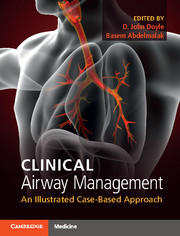Book contents
- Clinical Airway ManagementAn Illustrated Case-Based Approach
- Clinical Airway Management
- Copyright page
- Dedication
- Contents
- Contributors
- Foreword
- Preface
- Acknowledgments
- Section 1 Introduction
- Section 2 Basic Airway Management
- Section 3 The Anticipated Difficult Airway
- Section 4 The Unanticipated Difficult Airway
- 24 Unanticipated Anterior Larynx
- 25 Emergency Surgical Airway
- 26 Airway Management in a Thrombocytopenic Parturient for Urgent C-Section
- 27 Airway Management of the Morbidly Obese
- 28 Fresh Tracheotomy: Problems and Precautions
- Section 5 Lower Airway Management
- Section 6 Airway Emergencies and Special Situations
- Section 7 When the Airway Goes Bad
- Appendix: The Art and Science of Awake Fiberoptic Intubation
- Index
- References
27 - Airway Management of the Morbidly Obese
from Section 4 - The Unanticipated Difficult Airway
Published online by Cambridge University Press: 03 March 2017
- Clinical Airway ManagementAn Illustrated Case-Based Approach
- Clinical Airway Management
- Copyright page
- Dedication
- Contents
- Contributors
- Foreword
- Preface
- Acknowledgments
- Section 1 Introduction
- Section 2 Basic Airway Management
- Section 3 The Anticipated Difficult Airway
- Section 4 The Unanticipated Difficult Airway
- 24 Unanticipated Anterior Larynx
- 25 Emergency Surgical Airway
- 26 Airway Management in a Thrombocytopenic Parturient for Urgent C-Section
- 27 Airway Management of the Morbidly Obese
- 28 Fresh Tracheotomy: Problems and Precautions
- Section 5 Lower Airway Management
- Section 6 Airway Emergencies and Special Situations
- Section 7 When the Airway Goes Bad
- Appendix: The Art and Science of Awake Fiberoptic Intubation
- Index
- References
- Type
- Chapter
- Information
- Clinical Airway ManagementAn Illustrated Case-Based Approach, pp. 146 - 150Publisher: Cambridge University PressPrint publication year: 2000

